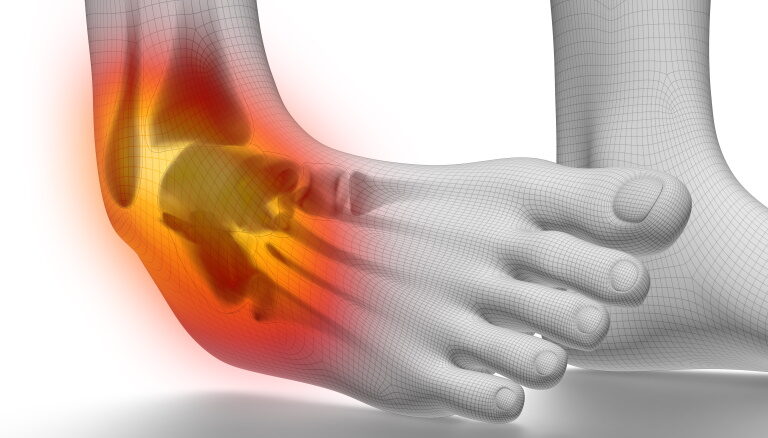Can Torn Ligaments In The Ankle Be Repaired Without Surgery
Lateral ligament talocrural joint sprain: how to treat it properly
A lateral ligament ankle sprain occurs when the ligaments on the exterior of the ankle are stretched across their limits. Injury to these ligaments causes hurting and swelling in the ankle. Generally, most lateral ligament talocrural joint sprains are minor and volition get ameliorate with elementary treatments. Yet, more astringent cases tin weaken the ankle leading to repeated sprains and chronic talocrural joint pain. Then, how practise y'all diagnose a tear of the ankle ligaments and what do you practise?
What are the lateral ligaments?
Ligaments are strong fibrous structures that connect bones to other bones. In that location are three ligaments connecting the pinnacle and bottom of the talocrural joint articulation on the outside of the talocrural joint. In general, spraining the talocrural joint amercement one or more of these ligaments.
Causes
A Lateral ligament ankle sprain occurs when the talocrural joint rolls inward or twists. Mostly, your ankle twists during many activities such as walking or running on uneven surfaces, playing sport involving change of management, or an unexpected fall.
Usually, the more than times you lot sprain your talocrural joint, the more likely y'all'll sprain it over again.
Clinical findings of a lateral ligament ankle sprain
In general, a sprained talocrural joint causes pain on the outside of the ankle. Other symptoms include:
- a pop or cleft sound at the time of the injury
- swelling which forms immediately or overnight
- bruising
- stiffness due to inflammation, which is worse in the morning and improves with activity
- instability of the ankle articulation – this may occur with consummate tearing of the ligaments
- tenderness at the ligaments
Usually, your doctor will diagnose an ankle sprain by careful examination of the talocrural joint and foot. As a rule, it is important to make certain that you don't accept a break (fracture) or cartilage injury. Often, an 10-ray, ultrasound, or MRI is needed to confirm a lateral ligament tear and rule out other injuries.
Handling of lateral ankle ligament sprain

Well-nigh all ankle sprains can be treated without surgery. Even complete ligament tears get better with treatment such as bracing and physiotherapy. Overall, merely considering you tear your ligaments doesn't mean you demand surgery.
In general, we suggest a three-phase process to go you dorsum to sport:
- Stage 1 includes rest from sport, pinch, and regular icing to limit swelling. A short course of ibuprofen can help. Too, a modest bandage boot may provide extra support.
- Phase 2 includes range of motion exercises, stretching, and dogie strengthening. Residue exercises are important to foreclose a recurrence.
- Phase iii involves circuitous exercises and gradual return to running and alter of direction activity. Your therapist will introduce agility drills to exam the ankle.
Ankle sprain getting worse and not better: what to do
On average, almost 10% of ankle sprains exercise not get amend with simple treatments. In these cases, it may be useful to run across your medico and explore imaging to confirm the diagnosis. More often than not, we need ultrasound or MRI to diagnose other problems such equally a tendon tear or ankle cartilage harm.
Examples of other damage to the talocrural joint include:
- breaks in the small bones of the ankle such every bit the anterior procedure of calcaneus, base of 5th metatarsus or bone trigonum
- cartilage damage in the ankle joint
- tears of tendons such equally peroneal tendons
- damage to other joints such as subtalar joint or loftier ankle sprain.
Every and then often, an injection is useful to help with therapy. For case, a common cause of ankle pain afterwards a sprain is persistent inflammation in the ankle joint. A cortisone injection directed to this inflammation tin reduce pain and allow for more rehab. Generally, we perform injections with ultrasound to improve accuracy. A minor needle is inserted into the area of inflammation. Ultrasound allows us to avoid important nerves and blood vessels.
Occasionally, surgery is needed to remove the inflammation or reconstruct the ligaments. Ordinarily, nosotros refer to surgery for cases that neglect rehab.
Commonly asked questions most ankle sprains:
Why do I keep twisting my ankles?
Generally, repeated ankle twists atomic number 82 to more damage to the outside ligaments meaning that you lot're more than likely to twist again. Therefore, we stress the importance of seeing a therapist afterward a sprain to forestall futurity sprains.
Why won't my ankle heal afterwards a sprain?
Not all sprained ankles involve only ligament damage. Sometimes, rolling your ankle tin damage other structures such as tendons or cartilage. In these cases, nosotros recommend you see an experienced doctor who can sort out the reason for your ongoing ankle bug.
Can torn talocrural joint ligaments heal without surgery?
Yeah. Even in tears of all the ligaments on the outside of the ankle, the talocrural joint can regain full part without surgery. We suggest a short period of residuum in a walking boot followed by slow physiotherapy.
Deltoid ligament sprain: Do we treat information technology differently?
The deltoid ligament on the inside of the ankle is much larger and stronger than the lateral ligaments. Therefore, a tear of the deltoid ligaments is in fact a more serious injury that requires longer rehab. In complete tears of the deltoid ligament, nosotros recommend a surgical repair.
Final word from Sportdoctorlondon
Not all talocrural joint injuries are benign and settle with physiotherapy. You should run into an expert sports doctor to correctly diagnose and manage your difficult ankles.
Other human foot and ankle weather:
- Plantar fasciitis
- Baxters nerve entrapment
- Morton's neuroma
- Achilles tendinopathy
- Calcaneal stress fracture
- Navicular stress fracture
- Posterior tibial tendonitis
- Bone trigonum: a cause of pain at the back of the ankle
Dr. Masci is a specialist sport doctor in London.
He specialises in musculus, tendon and articulation injuries.

Share This Story, Cull Your Platform!
Can Torn Ligaments In The Ankle Be Repaired Without Surgery,
Source: https://sportdoctorlondon.com/lateral-ligament-ankle-sprain/
Posted by: morgantabstair.blogspot.com




0 Response to "Can Torn Ligaments In The Ankle Be Repaired Without Surgery"
Post a Comment